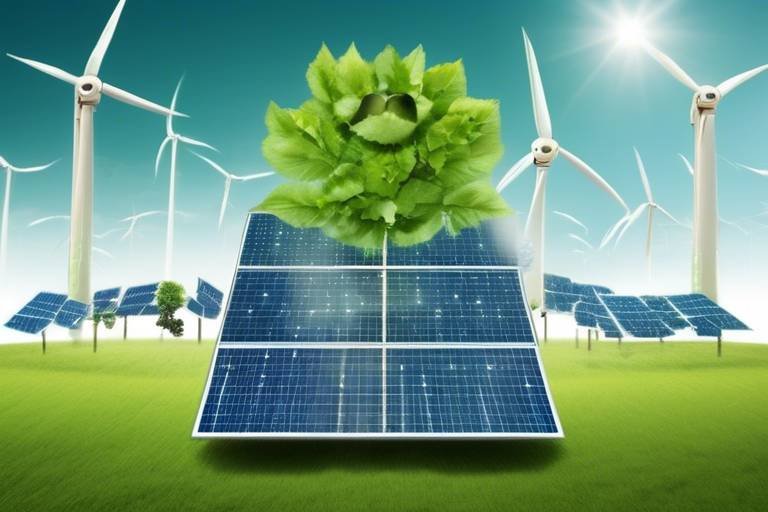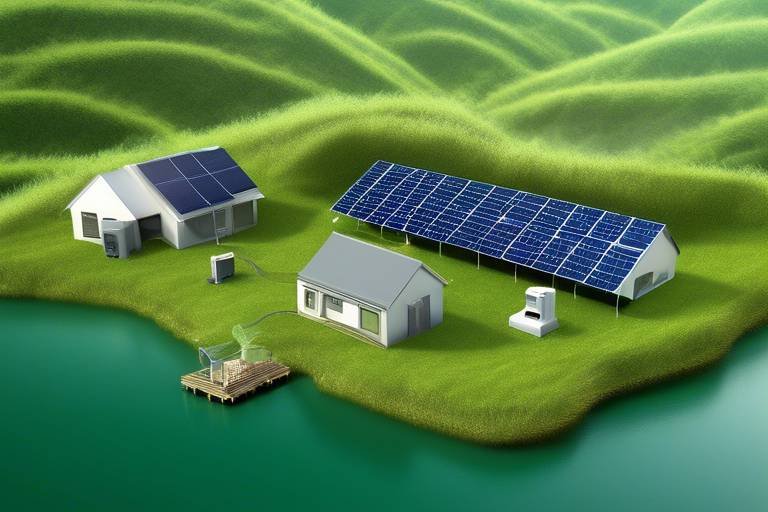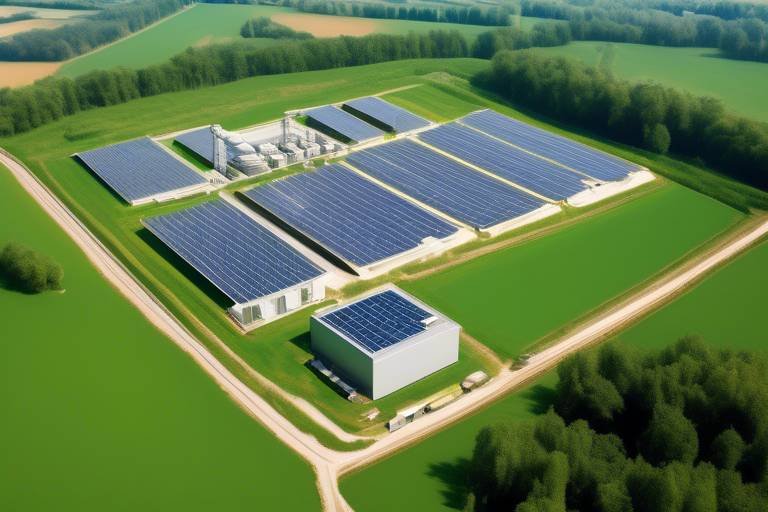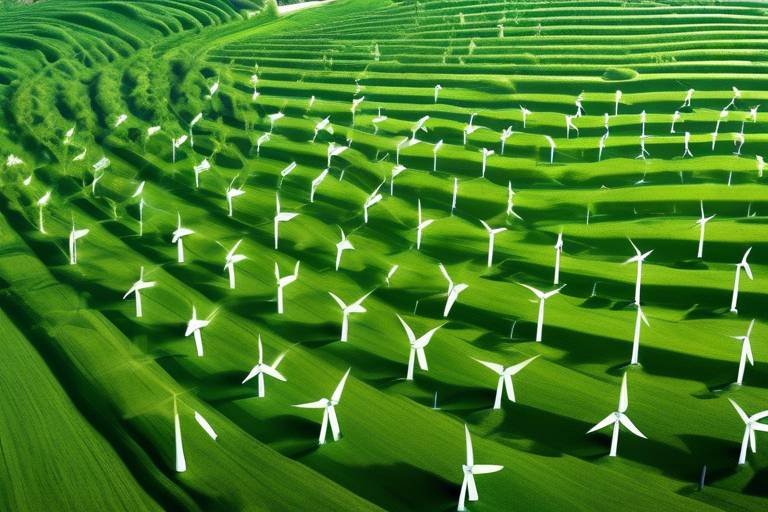How to Encourage Green Energy Usage in Your Community
In today's world, the push for sustainable living is more critical than ever. Encouraging green energy usage in your community isn't just about saving the planet; it's about creating a healthier, more economically viable future for everyone. Imagine a neighborhood powered by the sun, wind, and other renewable sources, where air pollution is a thing of the past, and residents are saving money on their energy bills. Sounds appealing, right? Well, this article dives into the various strategies and initiatives that can help make this vision a reality. Let's explore how we can work together to promote green energy usage and make our communities thrive.
So, what exactly is green energy? In simple terms, green energy refers to energy derived from natural, renewable sources that have a minimal impact on the environment. This includes solar, wind, hydro, and geothermal energy. As our planet grapples with the dire consequences of climate change, the significance of green energy cannot be overstated. By shifting our energy consumption patterns, we can dramatically reduce our carbon footprints and combat the adverse effects of global warming. It's like switching from a gas-guzzling car to a sleek electric vehicle; the benefits are clear, and the impact is profound.
Transitioning to green energy offers a plethora of advantages that extend beyond just environmental protection. Let's break down some of the most compelling benefits that communities can enjoy when they embrace renewable energy sources.
One of the most attractive aspects of switching to green energy is the potential for significant cost reductions in energy bills. By investing in renewable energy technologies, communities can harness local resources and reduce their dependence on costly imported fossil fuels. For instance, solar panels can drastically cut electricity costs, and over time, the initial investment pays off. Think of it as planting a tree: the initial effort and resources may seem daunting, but the long-term shade and fruit it provides are worth every bit of effort.
The green energy sector is booming and is a hotbed for job creation. As communities invest in renewable energy projects, they simultaneously create numerous job opportunities in fields such as installation, maintenance, and research. This not only boosts local employment rates but also stimulates the economy. Just picture a local solar farm employing dozens of technicians and engineers; it’s a win-win situation for everyone involved!
By relying on local renewable energy sources, communities can enhance their energy independence. This means reducing reliance on imported fossil fuels, which can be both costly and environmentally damaging. When communities generate their own energy, they can control costs and ensure a stable energy supply. It’s akin to growing your own vegetables; you know exactly where they come from, and you’re less vulnerable to market fluctuations.
Adopting green energy not only benefits the environment but also leads to improved public health. Cleaner air and water are direct results of reducing pollution from traditional energy sources. When communities shift towards renewable energy, they significantly decrease harmful emissions that contribute to respiratory issues and other health problems. Imagine a community where children play outside without the worry of air pollution affecting their health; that’s the kind of future we can create through green energy initiatives.
Engaging community members is crucial for promoting green energy. Without active participation, even the best initiatives can fall flat. So, how do we get everyone on board? Here are some effective strategies to involve residents in green initiatives and encourage sustainable practices.
Raising awareness about the benefits of green energy is essential. Educational campaigns can inform and motivate community members to adopt renewable energy solutions. Think about hosting workshops, community meetings, or even social media campaigns that highlight the advantages of green energy. The more people know, the more likely they are to get involved!
Offering incentives can significantly increase participation in green energy initiatives. Whether it’s tax rebates for solar panel installation or discounts on energy-efficient appliances, these programs can encourage residents to make the switch. By providing tangible benefits, communities can create a buzz around green energy that’s hard to ignore.
Q: What is green energy?
A: Green energy refers to energy sourced from renewable resources that have a minimal environmental impact, such as solar, wind, and hydro energy.
Q: How can my community benefit economically from green energy?
A: Communities can save money on energy bills, create jobs in the renewable energy sector, and achieve energy independence by investing in local renewable energy sources.
Q: Are there health benefits associated with green energy?
A: Yes, transitioning to green energy leads to cleaner air and water, which can significantly improve public health by reducing pollution-related illnesses.

Understanding Green Energy
Green energy refers to energy derived from renewable resources that are naturally replenished. These sources include sunlight, wind, rain, tides, waves, and geothermal heat. In contrast to fossil fuels, which release harmful pollutants and contribute to climate change, green energy offers a cleaner, more sustainable alternative. As we grapple with the escalating effects of climate change, the significance of green energy becomes increasingly apparent. It plays a crucial role in reducing our carbon footprint and mitigating the adverse impacts of pollution on our planet.
One of the most compelling reasons to embrace green energy is its potential to combat climate change. The burning of fossil fuels releases significant amounts of carbon dioxide and other greenhouse gases into the atmosphere, which trap heat and lead to global warming. By transitioning to renewable energy sources, we can significantly decrease these emissions. For instance, solar panels and wind turbines generate electricity without emitting greenhouse gases, making them vital tools in our fight against climate change.
Moreover, green energy sources are abundant and widely available. Unlike fossil fuels, which are finite and subject to geopolitical tensions, renewable resources can be harnessed almost anywhere. For example, regions with ample sunshine can take advantage of solar energy, while areas with strong winds can utilize wind turbines. This geographical flexibility not only promotes energy independence but also ensures that communities can tailor their energy solutions to their specific environmental conditions.
It's essential to recognize that the transition to green energy isn't just about environmental benefits; it also encompasses economic and social dimensions. By investing in renewable energy technologies, communities can foster job creation and stimulate local economies. The green energy sector is rapidly expanding, with a growing demand for skilled workers in areas such as solar panel installation, wind turbine maintenance, and energy efficiency consulting. This shift toward renewable energy can lead to a more resilient economy, less susceptible to the volatility of fossil fuel markets.
In conclusion, understanding green energy is crucial for anyone looking to make a positive impact on their community and the environment. As we explore various strategies to promote its usage, it's vital to recognize that adopting green energy is not merely a trend; it is a necessary step toward a sustainable future. By embracing renewable energy sources, we can reduce our carbon footprint, create jobs, and ensure a healthier planet for generations to come.

Benefits of Green Energy
Adopting green energy is not just a trend; it’s a transformative movement that brings a multitude of benefits to communities. Imagine a world where energy is clean, abundant, and sustainable. This isn’t just a dream; it’s a reality that many communities are beginning to embrace. The shift towards renewable energy sources, such as solar, wind, and hydroelectric power, offers a plethora of advantages that extend beyond environmental concerns. Let’s dive into some of the key benefits of transitioning to green energy.
One of the most compelling reasons to support green energy is the potential for economic savings. By investing in renewable energy technologies, communities can significantly reduce their energy bills. For instance, solar panels can harness the sun's power, leading to lower electricity costs. Over time, this can result in substantial savings for households and businesses alike. According to recent studies, communities that have adopted solar energy have seen their energy expenses drop by up to 50%. This financial relief can be reinvested into local economies, fostering growth and development.
Moreover, the green energy sector is a powerhouse for job creation. As more communities invest in renewable energy, new job opportunities emerge in various fields, including installation, maintenance, and research. This burgeoning industry not only provides employment but also encourages local workforce development. For example, a study by the U.S. Department of Energy found that the solar industry alone employed over 250,000 workers in recent years, and this number is only expected to grow. By promoting green energy initiatives, communities can boost their local employment rates and foster a sustainable job market.
Another significant benefit of green energy is the enhancement of energy independence. By relying on local renewable energy sources, communities can reduce their dependence on imported fossil fuels. This shift not only strengthens local economies but also increases resilience against fluctuating energy prices and geopolitical tensions. Imagine a community that generates its own power—free from the whims of international oil markets. This independence can lead to greater stability and security for local residents.
Beyond economic benefits, green energy has profound health benefits. By transitioning away from traditional fossil fuels, communities can reduce air and water pollution, leading to improved public health outcomes. Cleaner air means fewer respiratory issues, lower healthcare costs, and a higher quality of life for residents. Studies have shown that communities that adopt renewable energy sources experience a decrease in asthma rates and other pollution-related health problems. It’s a win-win situation where both the planet and the people thrive.
In summary, the benefits of green energy extend far beyond just environmental protection. From significant economic savings and job creation to enhanced energy independence and improved public health, the advantages are compelling. By embracing renewable energy, communities can pave the way for a brighter, more sustainable future.
- What is green energy? Green energy refers to renewable energy sources that are environmentally friendly and sustainable, such as solar, wind, and hydroelectric power.
- How can green energy save money? By utilizing renewable energy sources, communities can reduce their energy bills significantly, leading to long-term financial savings.
- Does green energy create jobs? Yes, the green energy sector is rapidly growing and creates numerous job opportunities in installation, maintenance, and research.
- What are the health benefits of green energy? Green energy reduces pollution, leading to cleaner air and water, which contributes to better public health outcomes.

Economic Savings
Switching to green energy isn't just about saving the planet; it's also about saving your hard-earned cash! When communities embrace renewable energy sources like solar, wind, and hydro, they often find themselves with significantly lower energy bills. Imagine waking up one day to see your electricity costs slashed in half—sounds pretty amazing, right? This isn't just a dream; it's a reality for many who have made the switch to green energy.
One of the primary reasons for these savings is that renewable energy sources are often less expensive to maintain compared to traditional fossil fuels. For instance, once a solar panel system is installed, the cost of sunlight is free! Furthermore, many states and local governments offer substantial incentives for those who invest in renewable energy technologies, such as tax credits, rebates, and grants. These financial perks can make the initial investment much more manageable, allowing more community members to join the green energy movement.
Let’s dive a bit deeper into the numbers. Here’s a quick comparison of average energy costs between traditional fossil fuels and renewable energy sources:
| Energy Source | Average Cost per kWh |
|---|---|
| Coal | $0.12 |
| Natural Gas | $0.10 |
| Solar | $0.07 |
| Wind | $0.05 |
As you can see from the table above, the shift to renewable energy can lead to significant cost reductions over time. Not only do communities save money, but they also contribute to a more sustainable future. This is a win-win situation!
Moreover, investing in green energy can lead to job creation within the community. As more people turn to renewable energy, the demand for skilled workers in the green sector rises. This creates local jobs in installation, maintenance, and even research and development. With more jobs comes more spending power, which can further stimulate the local economy.
In addition, energy independence is a crucial factor in economic savings. By relying on locally sourced renewable energy, communities can reduce their dependence on imported fossil fuels, which are often subject to price fluctuations and geopolitical tensions. This stability can lead to more predictable energy costs, allowing families and businesses to budget more effectively.
In conclusion, embracing green energy not only helps the environment but also leads to substantial for communities. From lower energy bills to job creation and energy independence, the benefits are clear. So, why not take the leap into the world of renewable energy? Your wallet—and the planet—will thank you!
- What is green energy? Green energy refers to renewable energy sources that are environmentally friendly, such as solar, wind, and hydroelectric power.
- How can my community start using green energy? Communities can start by investing in renewable energy projects, participating in local incentive programs, and encouraging residents to adopt green technologies.
- Are there financial incentives for switching to green energy? Yes! Many states and local governments offer tax credits, rebates, and grants to help offset the costs of renewable energy investments.
- What are the long-term savings of switching to green energy? Long-term savings can include lower energy bills, reduced maintenance costs, and potential job creation within the green sector.

Job Creation
When we talk about the transition to green energy, one of the most exciting aspects is the potential for . The green energy sector is not just about saving the planet; it's also about creating a vibrant economy that offers numerous employment opportunities. Think about it: as communities invest in renewable energy sources like solar, wind, and hydroelectric power, they are not only reducing their carbon footprint but also fostering an environment ripe for job growth.
According to recent studies, the green energy industry is projected to continue its rapid expansion, with millions of jobs expected to be created in the coming years. These jobs range from technical positions such as engineers and technicians to support roles in sales, marketing, and project management. For instance, the installation of solar panels requires skilled labor, and as more households and businesses opt for solar energy, the demand for qualified installers is skyrocketing.
Moreover, the ripple effect of job creation in green energy extends beyond direct employment. Local businesses, such as manufacturing plants for solar panels or wind turbines, will also see an uptick in demand, leading to further job opportunities. This is not just a win for the environment; it's a win for local economies. Consider the following:
| Job Type | Average Salary | Projected Growth (2020-2030) |
|---|---|---|
| Solar Photovoltaic Installers | $44,890 | 51% |
| Wind Turbine Technicians | $56,230 | 61% |
| Energy Efficiency Specialists | $69,000 | 28% |
As you can see, the job market is not just promising; it’s exploding with opportunities! By investing in green energy, communities can significantly boost their local economies. The jobs created in this sector are often well-paying and provide opportunities for advancement, which is essential for building a sustainable future.
Furthermore, green energy jobs tend to be more resilient in economic downturns. Unlike traditional fossil fuel jobs, which can be highly volatile, positions in renewable energy are often tied to long-term projects and government initiatives aimed at sustainability. This stability can provide a sense of security for workers and their families, fostering a stronger community overall.
In conclusion, the shift towards green energy is not just an environmental imperative; it is also a powerful economic strategy that can lead to significant job creation. By supporting local green initiatives, communities can ensure a sustainable future while also enhancing their economic landscape. So, let’s embrace this green revolution together and pave the way for a healthier planet and a thriving job market!

Energy Independence
Relying on local renewable energy sources is not just a trendy idea; it's a powerful step toward achieving . Imagine a community where the energy that powers homes, schools, and businesses comes from the sun, wind, or water right in your backyard. This shift not only nurtures a sense of self-sufficiency but also shields communities from the unpredictable fluctuations of global energy markets. When we depend less on imported fossil fuels, we gain greater control over our energy resources, making our economies more resilient and stable.
In many regions, energy independence can significantly reduce the economic burden associated with energy imports. Communities can invest in local renewable energy projects that keep funds circulating within the local economy rather than sending them overseas. This means more money for local businesses, schools, and public services. Think of it as turning your community into a self-sustaining ecosystem where energy is not just consumed but produced and managed locally.
Moreover, energy independence can enhance national security. By reducing our reliance on foreign energy sources, we can mitigate the risks associated with geopolitical tensions and supply chain disruptions. This is especially relevant in today’s world, where energy resources can become a source of conflict. A community that harnesses its own energy is not just protecting its environment; it’s also fortifying its future.
To visualize the impact of energy independence, consider the following table that outlines the benefits of transitioning to local renewable energy sources:
| Benefit | Description |
|---|---|
| Economic Resilience | Local energy production keeps money within the community, fostering local jobs and businesses. |
| Environmental Impact | Reduced carbon emissions and pollution from decreased reliance on fossil fuels. |
| Energy Security | Less vulnerability to foreign energy supply disruptions and price fluctuations. |
| Community Empowerment | Increased local involvement in energy decisions fosters a sense of ownership and responsibility. |
In conclusion, embracing renewable energy sources is about more than just sustainability; it's about creating a stronger, more resilient community. By investing in local energy solutions, we can pave the way for a future where our energy comes from the earth beneath our feet, rather than distant lands. So, let’s take the plunge into this green revolution and empower our communities to thrive independently!
- What is energy independence?
Energy independence refers to a community's ability to produce its own energy through local renewable sources, reducing reliance on imported fuels. - How can communities achieve energy independence?
Communities can invest in renewable energy projects such as solar panels, wind turbines, and bioenergy systems to generate local energy. - What are the economic benefits of energy independence?
Energy independence can lead to cost savings, job creation, and a more stable local economy by keeping energy spending within the community. - Are there environmental benefits to energy independence?
Yes, by utilizing renewable energy sources, communities can significantly reduce their carbon footprint and lower pollution levels.

Health Benefits
When we talk about green energy, we often focus on its environmental and economic advantages, but let’s not overlook the it brings to our communities. Imagine breathing in fresh, clean air instead of the polluted air filled with harmful emissions from fossil fuels. This is not just a dream; it can be our reality if we embrace renewable energy sources like solar, wind, and hydroelectric power. By transitioning to these cleaner energy options, we can significantly reduce air and water pollution, which directly impacts our health.
Studies have shown that areas reliant on green energy experience lower rates of respiratory diseases, cardiovascular problems, and other health issues linked to pollution. This is particularly important for vulnerable populations, such as children and the elderly, who are more susceptible to the adverse effects of poor air quality. For instance, according to the Environmental Protection Agency, reducing particulate matter in the air can lead to a 15% decrease in asthma cases. Just think about the lives we can improve!
Moreover, the benefits extend beyond just cleaner air. Green energy initiatives often promote a healthier lifestyle by encouraging outdoor activities and community engagement. When neighborhoods are less polluted, people are more likely to spend time outside, whether it’s jogging, biking, or simply enjoying a walk in the park. This increased physical activity can lead to better mental health, reduced stress levels, and a stronger sense of community.
Let’s not forget about water quality. Traditional energy sources can lead to water contamination through spills and runoff. By utilizing green energy, we can protect our water sources, ensuring that everyone has access to clean drinking water. Clean water is essential for our health; it prevents diseases and supports overall well-being. The connection between clean energy and clean water is a vital aspect of community health that should not be underestimated.
In summary, the shift towards green energy is not just an environmental imperative; it’s a public health necessity. By investing in renewable energy, we are investing in the health of our communities. The benefits are clear: cleaner air, better water quality, and healthier lifestyles. It’s time to take action and embrace the change that green energy can bring!
- What are the main health benefits of green energy? Green energy reduces air and water pollution, leading to fewer health issues such as respiratory diseases and improved overall public health.
- How does green energy impact community well-being? By promoting cleaner air and encouraging outdoor activities, green energy initiatives enhance mental and physical health, fostering a stronger community bond.
- Can switching to green energy improve water quality? Yes, using renewable energy sources minimizes the risk of water contamination associated with fossil fuel extraction and usage.

Community Engagement Strategies
Engaging community members is absolutely vital for promoting green energy. After all, what’s the point of having the best renewable technologies if no one is on board, right? It’s like having a shiny new car with no one to drive it! To truly foster a culture of sustainability, communities must implement effective strategies that not only inform but also involve residents in green initiatives. By doing so, we can create a collective consciousness around the importance of green energy, leading to sustainable practices that benefit everyone.
One of the most effective ways to engage the community is through awareness campaigns. These campaigns serve as a platform to educate residents about the benefits of green energy and how it can positively impact their lives. Imagine hosting a local event where families can learn about solar panels, wind turbines, and energy conservation techniques in a fun and interactive way. From workshops to informational booths at local fairs, these efforts can spark curiosity and motivate residents to take action. The key here is to make the information relatable—use stories, visuals, and even demonstrations to illustrate how green energy can transform lives.
In addition to awareness campaigns, offering incentive programs can significantly boost participation in green energy initiatives. Who doesn’t love a good deal? By providing financial incentives such as tax credits, rebates, or grants, communities can encourage residents to invest in renewable energy solutions. For instance, consider a program that offers a rebate for installing solar panels or a discount on energy-efficient appliances. These incentives not only make green energy more accessible but also create a sense of community ownership over local renewable projects.
Furthermore, establishing community partnerships can amplify engagement. Collaborating with local businesses, schools, and nonprofits can create a robust network of support for green initiatives. For example, schools can incorporate environmental education into their curricula, while local businesses can sponsor renewable energy projects. This not only raises awareness but also fosters a sense of unity among residents. When community members see their neighbors and local leaders participating in green initiatives, they are more likely to get involved themselves.
Lastly, it’s crucial to create a feedback loop. Engaging the community doesn’t stop at awareness and incentives; it’s also about listening to their concerns and suggestions. Organizing town hall meetings or online forums can provide a space for residents to voice their opinions on green energy initiatives. This not only empowers individuals but also helps local leaders understand the community's needs. By making residents feel heard, you cultivate a sense of belonging and responsibility towards the community’s sustainable future.
- How can I get involved in green energy initiatives in my community? Many communities offer volunteer opportunities for local environmental organizations. Check with your local government or community center for upcoming events and initiatives.
- What are some examples of incentive programs? Incentive programs can include tax credits for solar panel installations, rebates for energy-efficient appliances, or discounts on utility bills for using renewable energy sources.
- How can I educate my neighbors about green energy? Organizing a neighborhood workshop or hosting an informational session can be effective. Share resources, invite experts, and create a friendly environment for discussion.

Awareness Campaigns
When it comes to promoting green energy, awareness campaigns are like the spark that ignites a wildfire of change in a community. They serve as the foundation for educating residents about the myriad benefits of renewable energy sources. Imagine walking down your street and seeing vibrant posters and banners that not only capture attention but also inform people about how switching to green energy can lead to a healthier environment and substantial cost savings. It’s about creating a buzz that resonates with everyone, from the eco-conscious to those who might not have considered the impact of their energy choices.
One effective approach to awareness campaigns is utilizing social media platforms. These platforms allow communities to reach a broader audience quickly and efficiently. By sharing engaging content—such as infographics, videos, and testimonials—communities can illustrate the positive impacts of renewable energy. For instance, a short video showcasing local families who have made the switch to solar power can inspire others to follow suit. It's all about storytelling; when people see their neighbors benefiting from green energy, they are more likely to consider it themselves.
Additionally, hosting community events can significantly boost engagement. These events can range from informational workshops to fun festivals centered around sustainability. Imagine a weekend where families gather to participate in activities like solar panel demonstrations, energy-saving workshops, or even a local farmer’s market that emphasizes sustainable practices. Such events not only educate but also foster a sense of community and shared purpose. To make these events even more impactful, consider collaborating with local schools and organizations, creating a network of support that amplifies the message of green energy.
Moreover, providing educational materials is crucial. Distributing brochures, flyers, and newsletters can help keep the conversation going beyond the events. These materials should cover essential topics such as:
- The environmental benefits of green energy
- How to access renewable energy incentives
- Simple steps for residents to reduce their carbon footprint
By continuously providing valuable information, communities can maintain momentum in their green energy initiatives. The goal is to create a culture where sustainability is the norm, not the exception.
Finally, it’s essential to measure the impact of these awareness campaigns. Collecting feedback through surveys or community meetings can help assess what strategies are working and where improvements can be made. This iterative process not only enhances future campaigns but also demonstrates to residents that their opinions matter, fostering a sense of ownership in the community’s journey toward sustainability.
1. What are some effective ways to promote awareness about green energy in my community?
You can use social media, host community events, distribute educational materials, and collaborate with local organizations to spread the word about green energy.
2. How can I get involved in local green energy initiatives?
Start by attending community meetings, volunteering for local environmental groups, or participating in green energy workshops to learn more and contribute.
3. Are there any costs associated with switching to green energy?
While there may be initial costs for installation (like solar panels), many communities offer incentives and rebates that can significantly reduce expenses. Over time, the savings on energy bills often outweigh the initial investment.
4. Can awareness campaigns really make a difference?
Absolutely! Awareness campaigns can educate residents, inspire action, and create a collective movement toward adopting green energy solutions, leading to long-term environmental and economic benefits.

Incentive Programs
Incentive programs are a powerful way to encourage residents to embrace green energy solutions. Think of them as the carrot at the end of the stick, motivating individuals and businesses to make the switch to renewable energy. These programs can take various forms, from financial incentives to tax credits, and they play a crucial role in making green energy more accessible and appealing. For instance, many communities offer rebates for solar panel installations or grants for energy-efficient home upgrades. These incentives not only alleviate the initial financial burden but also highlight the long-term savings associated with renewable energy.
One of the most effective types of incentive programs is the tax credit. By reducing the amount of tax owed, these credits can significantly lower the overall cost of renewable energy installations. For example, the Federal Investment Tax Credit (ITC) allows homeowners to deduct a substantial percentage of the cost of solar systems from their federal taxes. This kind of support can make a world of difference for families considering solar energy, as it effectively reduces the payback period for their investment.
Additionally, many states and local governments have implemented net metering policies, which allow homeowners with solar panels to sell excess energy back to the grid. This not only helps to offset energy costs but also contributes to a more sustainable energy system. Imagine being able to power your home with clean energy and even earn money from it! It’s a win-win scenario that can transform the way communities think about energy consumption.
Furthermore, incentive programs can extend to businesses as well. For example, local governments might offer grants to companies that invest in energy-efficient technologies or renewable energy sources. This can lead to significant cost savings and boost a company’s green credentials, attracting environmentally conscious consumers. In this way, the ripple effect of these programs can benefit the entire community, creating a culture of sustainability and responsibility.
To illustrate the impact of these incentive programs, consider the following table that outlines some common incentives available in many communities:
| Incentive Type | Description | Potential Savings |
|---|---|---|
| Tax Credits | Reductions in tax obligations for investments in renewable energy. | Up to 30% of installation costs |
| Rebates | Direct cash incentives for installing energy-efficient appliances or systems. | Varies by program, often several hundred dollars |
| Grants | Funds provided to support renewable energy projects or energy efficiency upgrades. | Varies widely, can cover a significant portion of costs |
| Net Metering | Allows homeowners to sell excess energy back to the grid. | Reduces monthly energy bills |
Ultimately, the success of these incentive programs hinges on community engagement and awareness. It’s essential for residents to know what options are available to them and how they can benefit from participating in green energy initiatives. By promoting these programs effectively, communities can create a robust framework for sustainable energy practices that not only enhance environmental health but also foster economic growth.
- What are green energy incentive programs? These are initiatives designed to encourage the adoption of renewable energy by providing financial benefits such as tax credits, rebates, and grants.
- How can I find out what incentives are available in my area? You can visit your local government’s website or check with energy providers to learn about specific programs in your community.
- Are there any downsides to these incentive programs? While generally beneficial, some programs may have eligibility requirements or limited funding, so it's important to do your research.
Frequently Asked Questions
- What is green energy?
Green energy refers to renewable energy sources that are environmentally friendly, such as solar, wind, and hydroelectric power. These energy sources help combat climate change and reduce carbon footprints, making them crucial for a sustainable future.
- How can my community benefit from adopting green energy?
Adopting green energy can lead to significant economic savings, improved public health, and environmental protection. Communities can save on energy bills, create jobs in the green sector, and enjoy cleaner air and water.
- What are some examples of economic savings from green energy?
Switching to renewable energy technologies can drastically cut down energy costs. For instance, solar panels can reduce electricity bills, and community solar projects can provide affordable energy solutions for residents.
- How does green energy create jobs?
The green energy sector is rapidly growing, leading to numerous job opportunities in areas like installation, maintenance, and research. By investing in local renewable energy projects, communities can boost employment rates and stimulate the local economy.
- What is energy independence, and why is it important?
Energy independence means relying on local renewable energy sources instead of imported fossil fuels. This not only enhances a community's energy security but also keeps energy dollars circulating within the local economy.
- How does green energy impact public health?
Green energy contributes to cleaner air and water by reducing pollution from traditional energy sources. This leads to healthier communities, as lower pollution levels can decrease respiratory issues and other health problems.
- What strategies can engage my community in green energy initiatives?
Engaging community members can be achieved through awareness campaigns, educational workshops, and hands-on activities. These initiatives help inform residents about the benefits of green energy and encourage participation in sustainable practices.
- Are there any incentive programs for switching to green energy?
Yes! Many communities offer incentive programs such as tax credits, rebates, and grants to encourage residents to invest in renewable energy solutions like solar panels or energy-efficient appliances.
- How can I get involved in promoting green energy in my community?
You can start by educating yourself and others about the benefits of green energy, participating in local initiatives, and advocating for policies that support renewable energy development. Every little effort counts!



















